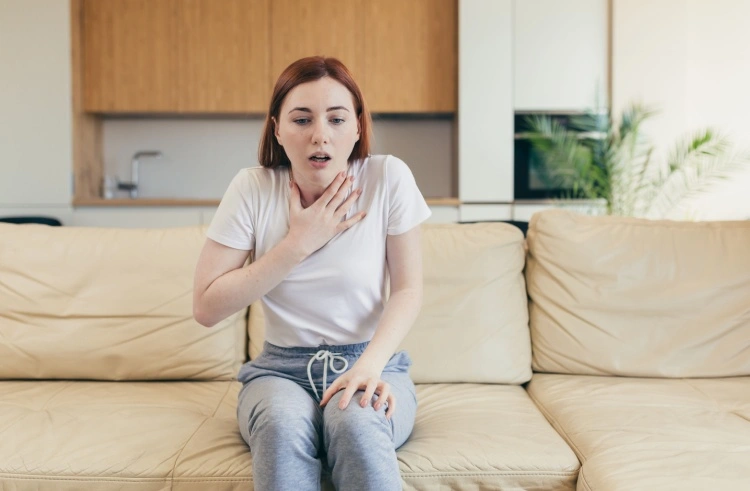Quick Facts
- Prevalence of panic disorders: 4.7% of U.S. adults
- Types of panic disorders: Type I, Type II, Type III, and Type IV
- Related disorders: Generalized anxiety disorder (GAD), phobias, obsessive-compulsive disorder (OCD), and post-traumatic stress disorder (PTSD)
- Groups affected: Adults, children, adolescents, and teens
- Symptoms of panic disorders: Feelings of being out of control, sweating, trembling, dizziness, weakness, chills, chest pain, numb or tingly hands, nausea, stomach pain
- Long-term effects of panic disorders: Poor quality of life, isolation, sadness, and possibly developing other mental health challenges
- Treatment options for panic disorders: Psychotherapy and medication
What Causes Panic Disorders?
We do not know why some people develop panic disorder. However, research suggests that several factors may be involved, including:
- Genetics
- Increased sensitivity to carbon dioxide
- Imbalances in neurotransmitters
Risk Factors
Risk factors are elements and medical conditions that increase the risk for developing panic disorders. Unlike causes, they do not necessarily lead to panic disorders.
Common risk factors include:
- Psychiatric or medical problems
- A family history of panic disorder
- Traumatic or stressful life events
- Substance abuse and smoking
- Pre-existing mental health conditions
- Major life stressors, such as developing a life-threatening illness, the serious illness, or death of a family member
- Major life changes, such as the birth of a child or divorce
- Tendencies toward catastrophic thinking (i.e., you tend to focus on minor physical issues or symptoms and interpret them as life-altering conditions such as cancer)
Symptoms of Panic Disorders
People experiencing panic disorders may experience a range of behavioral and physical symptoms.
Behavioral symptoms include:
- An avoidance or fear of places or situations that have caused panic attacks in the past
- Repeated and sudden panic attacks involving overwhelming fear and anxiety
- Constant worry about when the next panic attack will occur
- Feelings of impending doom, injury, or death without clear or logical triggers or causes
- Feelings of unreality
Physical symptoms of a panic attack include:
- Chest pain
- Numb or tingly hands
- Breathing problems
- Chills
- Racing or pounding heart (palpitations)
- Trembling
- Feeling like you’re going to get a heart attack
Types of Panic Disorders
One health journal has classified panic disorders into four types according to neurotic or depressive symptoms. The types are as follows:
- Type I: Patients only experience one single panic attack.
- Type II: Panic attacks happen frequently without any accompanying depressive or neurotic symptoms.
- Type III: Panic attacks recur (return), and the patient gradually develops neurotic symptoms.
- Type IV: The patient develops depressive symptoms as they experience recurring panic attacks. There are three subtypes of Type IV:
- Type IV-1: Depressive symptoms develop along with panic attacks and major depression.
- Type IV-2: Panic disorder changes into major depression.
- Type IV-3: Panic attacks and depressive symptoms are observed independently.
Type III and Type IV-1 are the most common types of panic disorders.
Effects of Untreated Panic Disorders
Untreated panic disorders can have severe effects. These include:
- Avoidance of social situations and a withering of relationships with family and friends
- Anxiety, depression, and other psychiatric disorders
- Social and performance issues at school or work
- Development of certain phobias that can limit your lifestyle and ability to do things, such as leaving your home, taking public transport, or driving
Treatment for Panic Disorders at Mark Behavioral Health
Mark Behavioral Health offers two main treatment types for panic disorders as part of a comprehensive care program: psychotherapy and medication.
Treatments are offered in our residential mental health program, or care that takes place in our residential mental health facility.
Psychotherapy
Psychotherapy is a mental health treatment approach where psychologists, psychiatrists, and other mental health providers treat mental health issues by talking to patients. It is also called counseling, talk therapy, and psychosocial therapy.
There are several types of psychotherapy:
- Acceptance and commitment therapy helps you understand your feelings and thoughts. It also helps you make changes and improve your coping skills.
- Cognitive behavioral therapy (CBT) helps you spot unhealthy behaviors and beliefs and learn better coping skills.
- Dialectical behavior therapy is a kind of CBT that teaches behavioral skills to help you manage your emotions, handle stress, and improve your relationships.
- Interpersonal psychotherapy focuses on problems with others. It can help you improve how you relate to friends, family, and co-workers.
- Psychodynamic and psychoanalysis therapies increase your awareness of behaviors and thoughts you may not be aware about.
- Supportive psychotherapy boosts your ability to deal with difficult situations and stress.
Medication
You may receive medication to treat panic disorder from providers. Depending on the type of panic disorder and your symptoms, you may receive:
- Beta-blockers can control some of the physical signs of panic disorder, such as tremors, sweating, and rapid heart rate.
- Antidepressants, such as serotonin-norepinephrine reuptake inhibitors (SNRIs) and selective serotonin reuptake inhibitors (SSRIs), can treat depression as well as panic disorder. They can cause side effects such as nausea, headaches, and sleeping problems.
- Benzodiazepines are anti-anxiety sedatives that can rapidly decrease panic attack symptoms. However, some people develop a tolerance for these drugs and may even become dependent on them.
Best Resources for Floridians With Panic Disorders
There are several resources for people living with panic disorders who want to learn more about their condition or want help in finding treatment.
The best resources for Florida residents with panic disorders include:
- Rootd is a mobile app for panic attacks and anxiety. It is available on Apple and Google Play. When you feel anxious, you can tap a big red button. The app will then help you face a panic attack straight on, or find comfort as soon as possible.
- NHS Inform has a guide on dealing with panic attacks. It outlines several tips, including breathing exercises and relaxation techniques for panic attacks.
- Anxiety & Depression Association of America (ADAA) offers free webinars, blogs, self-help book lists, support groups, health information, and links to resources about panic disorders, anxiety, depression, and other conditions that often occur alongside panic disorders. Use the site’s Find Your Therapist directory to find licensed mental health professionals who can help you with your panic disorder.
- 988 Suicide & Crisis Lifeline is a 24/7 free and confidential hotline for people struggling with mental health crises.
- Substance Abuse and Mental Health Services Administration provides information about substance abuse and mental health. It’s also home to a national database of behavioral and mental health treatment centers.
Get Top Care and Support for Panic Disorders in Florida
Panic disorders can be difficult to deal with, especially if you lack emotional support.
That’s where Mark Behavioral Health comes in. Our compassionate staff and health care providers will listen to your story and help you get the care and support you deserve. We provide services to various areas in South Florida.
Contact us today to learn how we can help you. We offer fully bilingual (English and Spanish) services, trauma-informed care, sexual abuse care, CBT, nutrition services, and more.


